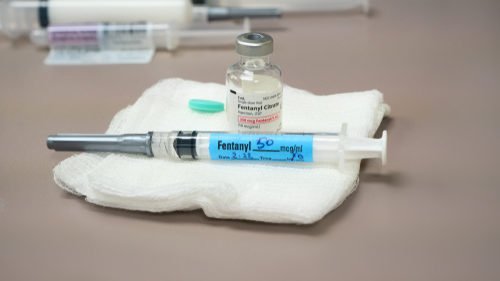Fentanyl is a highly potent synthetic opioid medication that is similar to morphine. It is used as a pain relieving medication for individuals in severe pain, most commonly after surgery. It can be administered as a shot, as a patch that an individual applies to his or her skin, or swallowed by way of sucking on a fentanyl lozenge. When sold illegally it can come in the form of a powder, nasal spray, dropped onto blotter paper, and/ or made into pills that appear similar to other prescription opioid medications. The United States Drug Enforcement Administration (DEA) classifies fentanyl as a Schedule II Controlled Substance. As such, it is considered to be a dangerous substance “with a high potential for abuse, with use potentially leading to severe psychological or physical dependence.” Due to the fact that the sale of illegal fentanyl is completely unregulated, the ingredients and potency of each batch produced is completely left to the discretion of the manufacturer. This leaves consumers unaware of the exact product they are purchasing, which can greatly increase the risk of adverse effects, including overdose.
Withdrawal
Withdrawal symptoms occur when an individual has developed a tolerance to fentanyl, whereby his or her body becomes accustomed to functioning with the substance present, and experiences an adverse reaction when there is a lack of the substance in his or her body. While withdrawal symptoms can develop within hours of one’s last dose of fentanyl, usually they begin between six and thirty-six hours after one’s last dose. Some commonly reported withdrawal symptoms, as provided by the Mayo Clinic include any combination of the following examples:
- Bone aches and pain
- Sweating
- Headaches
- Nausea
- Muscle cramping
- Diarrhea
- Sleep disturbances
- Anxiety
- Depression
- Agitation
- Hallucinations
- Seizures
The acute detox process and its associated withdrawal symptoms from fentanyl abuse can cause severe discomfort, which is why it is recommended for an individual to undergo detox in a medically supervised setting. This can help ensure the individual’s safety throughout the detox process, as well as provide medical intervention to help alleviate and/ or reduce the severity of some of the adverse withdrawal symptoms when deemed applicable. The length of time an individual will experience fentanyl withdrawal symptoms, beyond the acute detox stage, which typically lasts about forty-eight hours long, will vary.
For Information and Support
If you are concerned for yourself or a loved one in regards to substance abuse and/ or addiction we recommend reaching out for help as soon as possible. If left untreated, substance abuse can result in long lasting and potentially life-threatening consequences. Keep in mind: you are not alone! There is an entire network of professionals that are available to help and support you and your loved one throughout the recovery process. The earlier you seek support, the sooner your loved one can return to a happy, healthy, and fulfilling life.
Please do not hesitate to reach out with any questions regarding our specific program at Haven House Addiction Treatment and/ or general substance abuse and/ or addiction treatment related information. Our highly trained staff is readily available to discuss how we might best be able to help you and your loved one. We can be reached by phone at 424-258-6792. You are also welcome to contact anytime us via email at admissions@hhtxc.com.



